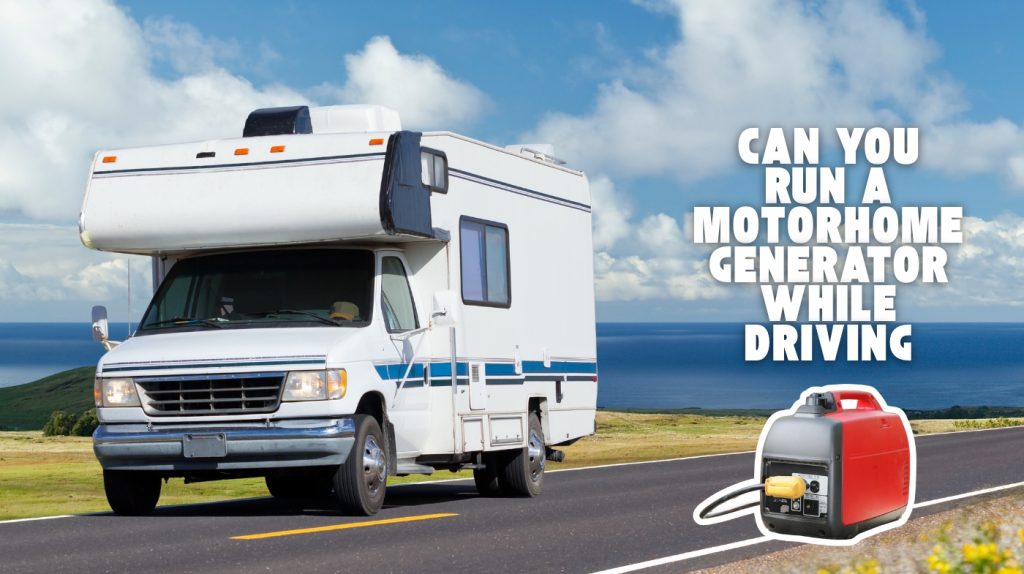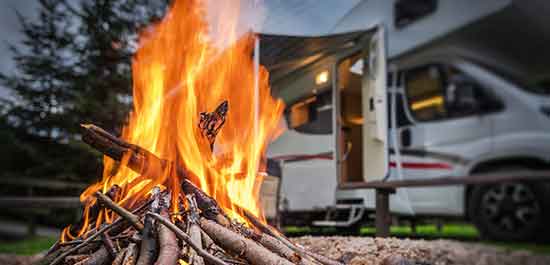You can run your motorhome generator while driving, but you must guarantee proper ventilation and safe exhaust positioning to avoid fume hazards. Manage your electrical load carefully to prevent overloads and monitor fuel consumption, as running the generator reduces fuel efficiency and driving range.
Follow legal regulations and maintain your generator regularly for reliable operation. Understanding these technical, safety, and efficiency aspects will help you optimize generator use during transit and avoid common pitfalls.
Key Takeaways
- You can run a motorhome generator while driving if it is properly installed with secure mounts and adequate ventilation to prevent exhaust buildup.
- Running the generator while driving increases fuel consumption and reduces overall vehicle fuel efficiency by about 0.2–0.5 MPG.
- Ensure balanced power loads and avoid overloading the generator by prioritizing critical appliances during transit.
- Regular maintenance and safety checks, including exhaust and fuel line inspections, are essential for safe generator operation on the move.
- Follow state laws and safety guidelines, including proper exhaust positioning and carbon monoxide precautions, when running the generator while driving.
Safety Considerations for Operating a Generator on the Road
When running a motorhome generator on the road, you must prioritize safety to protect yourself and others from hazards like carbon monoxide poisoning, mechanical failures, and electrical faults.
Always operate the generator outdoors with proper ventilation, maintaining at least 20 feet of distance from the motorhome to prevent CO infiltration through vents or windows.
Position exhaust outlets away from the RV and other units to avoid fume accumulation. Use canopies that fit squarely over the generator to protect against weather without blocking exhaust.
Additionally, ensure you have an Electrical Management System to monitor electrical conditions while the generator is running. Securely mount the generator to prevent shifting, regularly inspect fasteners, and maintain oil and fuel systems to ensure reliable operation.
Use neutral bonded grounding plugs and rated extension cords to protect electrical components. Turn off sensitive electronics during startup and shutdown to prevent surges.
Avoid enclosed spaces and confirm local regulations to guarantee safe and compliant generator use while driving. Carry backup fuel in fuel-approved containers and store it safely away from heat sources and the generator to reduce fire hazards.
How Fuel Consumption Is Affected by Generator Use While Driving?
When you run your motorhome’s generator while driving, expect increased fuel consumption since it draws from the same fuel tank as the engine. This shared fuel supply means generator use accelerates overall fuel depletion.
Typically, running a generator can reduce fuel efficiency by approximately two to four liters per hour depending on the load. Making fuel level monitoring essential during trips. Keeping an eye on fuel levels helps you balance comfort and efficiency without risking unexpected shortages.
Additionally, choosing a generator with economy mode can help optimize fuel consumption and extend runtime during travel.
Increased Fuel Usage
Although running your motorhome’s generator while driving provides essential power for appliances and climate control, it directly increases your fuel consumption. Generator operation typically adds about 0.3 to 1 gallon of fuel burned per hour depending on size and load.
This additional fuel use reduces your motorhome’s overall miles per gallon (MPG), sometimes lowering efficiency by 0.2 to 0.5 MPG. The increased fuel burn impacts trip costs and fuel budgeting considerably, especially on long drives.
Key factors to contemplate include:
- Generator size and load level affect hourly fuel consumption.
- Running multiple appliances or A/C raises fuel use.
- Diesel generators usually consume less fuel than propane ones.
- Extended generator use compounds fuel costs.
- Ambient temperature influences electrical demand and fuel burn.
Monitoring these variables helps you manage fuel efficiency while running your generator on the move. Using efficient, space-saving RV appliances and accessories can help reduce the overall electrical load and fuel consumption during generator operation.
Shared Fuel Supply
Drawing fuel from the motorhome’s main tank, the generator adds to your overall consumption without contributing to vehicle propulsion. This shared fuel supply means the generator’s fuel burn is additive, not multiplicative, to the engine’s usage. Proper maintenance of the generator’s fuel system can help optimize fuel efficiency during operation.
Typically, generators consume 2 to 4 liters per hour depending on electrical load, which can reduce highway fuel efficiency by about 0.5 to 0.75 MPG. Higher electrical demand, such as running rooftop air conditioners, increases this consumption, while minimal loads keep it lower.
Since both engine and generator draw from the same fuel reserve, running the generator while driving decreases your available driving range and necessitates more frequent refueling. Some generators incorporate automatic shutdown protocols at low fuel levels to preserve enough fuel for propulsion during transit.
Running the generator while driving typically adds about 0.5 gallons/hour to fuel consumption, which is comparable to the load of dash air conditioning systems.
Fuel Level Monitoring
How can you effectively monitor fuel levels to manage the increased consumption caused by running a motorhome generator while driving? Since generators add roughly 2 liters (0.5 gallons) per hour to fuel use, keeping a close eye on your fuel gauge is vital.
You’ll want to track fuel levels to avoid unexpected shutdowns and guarantee your driving range isn’t compromised.
- Use digital fuel monitoring systems for real-time accuracy and consider integrating battery management systems to optimize energy use.
- Check fuel level frequently, especially during extended generator use
- Account for an approximate 5–10% decrease in MPG when planning trips
- Prioritize essential appliances to reduce generator load and fuel draw
- Monitor generator auto-shutdown thresholds (typically around 1/4 tank) to preserve fuel reserve, as the generator automatically shuts down to prevent complete fuel depletion and ensure safe driving
Accurate fuel monitoring helps balance power needs with efficient fuel management on the road.
Managing Electrical Loads and Appliance Power During Transit
You need to monitor the generator’s load capacity closely to avoid overloading it during transit. Prioritize essential appliances and distribute power to maintain system stability and fuel efficiency.
Implementing a clear power management strategy guarantees safe and effective use of onboard electrical systems while driving. Regular maintenance and timely replacement of components, similar to tire maintenance practices, ensure reliable generator performance.
Appliance Load Limits
Although motorhome generators deliver between 3,000 to 5,000 watts of power, managing appliance loads carefully is essential to prevent exceeding their capacity during transit. Overloading the generator can cause shutdowns, reduce its lifespan, and increase maintenance needs. Regular maintenance and proper evaluation ensure optimal performance and longevity of the generator.
You should prioritize critical appliances like air conditioners, which may require additional surge wattage at startup. Non-essential devices need to be minimized or staggered to avoid simultaneous high draws. Batteries can supplement peak demands but only if they’ve sufficient capacity.
Key considerations include:
- Monitor total wattage to stay below generator ratings
- Limit use of high-power appliances simultaneously
- Use energy-efficient or soft-start devices when possible
- Balance loads between generator and battery support
- Avoid continuous operation near maximum output to protect equipment
Additionally, ensuring the generator is properly installed helps prevent operational problems and fuel starvation during travel.
Power Distribution Strategies
When managing electrical loads during transit, integrating power sources efficiently becomes essential to maintain system stability and appliance performance. Use automatic transfer switches to seamlessly alternate between shore and generator power without manual intervention.
Hardwired connections offer cost savings but require manual switching and increase risk of errors. Employ inverters with pass-through features to optimize efficiency by allowing power to bypass the inverter when available from shore or generator.
Manage loads via distribution panels equipped with circuit breakers to selectively control appliances and prevent overloading. Prioritize critical loads and shed nonessential ones to stabilize power draw.
Monitor real-time consumption and adjust appliance use to optimize fuel and battery usage. Ensure proper grounding and wiring are maintained for safety when operating generators while driving, avoiding electrical conflicts or damage within the motorhome system.
Additionally, incorporating an RV battery monitor helps track power usage and battery health in real time, preventing unexpected failures and enhancing overall energy efficiency.
Technical Requirements and Maintenance for Mobile Generator Use
Since mobile generator use involves continuous operation at low RPMs and exposure to road vibrations, understanding the technical specifications and maintenance demands is essential for reliable performance.
You’ll need to choose a suitably sized engine—typically 12-14 HP at 1,800 RPM—to guarantee adequate power output and durability. Selecting a generator with a slower RPM engine also helps reduce noise and mechanical wear, enhancing longevity.
Using materials with high durability, such as stainless steel components in mounting hardware, can improve vibration resistance. Proper integration with your RV’s electrical system, including automatic transfer switches and split-phase wiring, prevents overloads and backfeed hazards.
Routine maintenance is critical given the generator’s constant low-speed operation and vibration exposure. Key considerations include:
- Engine size and RPM for peak power and quiet operation
- Regular oil and filter changes to sustain efficiency
- Inspection of mounts and vibration isolators
- Monitoring fuel supply to prevent shutdowns
- Ensuring professional electrical system installation and safety compliance
Legal and Environmental Regulations Impacting Generator Operation
Understanding the legal and environmental regulations surrounding generator operation in motorhomes is essential for safe and compliant use. While most states permit running generators while driving, laws vary on passenger safety and emissions.
You must follow federal and local emissions limits and noise restrictions, especially in campgrounds. Proper installation and ventilation are legally required to prevent carbon monoxide risks. Using battery tenders can help maintain your motorhome’s battery health while minimizing generator run time.
Fuel use and storage are also regulated to avoid hazards. Additionally, some states enforce road restrictions that may limit generator use in certain areas for safety and compliance reasons.
| Regulation Type | Key Requirements |
|---|---|
| Legal | State laws on generator use while driving |
| Environmental | Emissions limits and noise controls |
| Safety | Installation, ventilation, carbon monoxide prevention |
| Fuel & Operation | Fuel type, storage, and fire safety rules |
Practical Tips for Efficient Generator Use While Driving
Although running a motorhome generator while driving slightly increases fuel consumption, you can optimize efficiency by following proper operation and maintenance procedures.
Start the generator while rolling to keep it cool and exercise the unit. Prime the fuel system before starting and allow it to run unloaded for two minutes to stabilize.
Turn off high-draw appliances before starting to reduce initial load. Using a running hour meter helps track maintenance intervals and ensures timely servicing of the generator, which is crucial for its longevity and reliability running hour meter.
Regularly inspect exhaust and fuel lines to prevent leaks and maintain safety.
- Engage low power appliances first after warm-up to avoid electrical surges
- Use fresh fuel and change filters routinely for consistent performance
- Position the generator exhaust at least 1 inch beyond the RV to vent gases safely
- Stagger high-wattage device use, especially air conditioners, to manage load
- Clean the exterior without pressurized water to prevent damage
Troubleshooting Common Issues With Motorhome Generators on the Move
Managing your motorhome generator while driving involves more than just efficient operation it requires quick identification and resolution of common issues that can arise on the move.
First, inspect fuel and oil systems: low oil pressure or clogged fuel filters often cause automatic shutdowns. Check fuel lines for steady flow, especially if you share the fuel tank with the engine. It is also important to verify that the fuel pump operation is steady and unobstructed to maintain consistent power delivery.
Electrical issues like loose wiring, corroded connectors, or tripped breakers can interrupt generator function; secure connections and reset breakers as needed. Mechanical factors—such as faulty sensors triggered by vibration or clogged air filters—also cause stoppages.
Monitor starter solenoids and relays for wear from road-induced vibration. Regularly inspect transfer switches and power surge protections to avoid malfunctions. Prompt troubleshooting guarantees dependable generator operation during travel.
Frequently Asked Questions
Can I Run a Portable Generator Inside a Motorhome While Driving?
No, you shouldn’t run a portable generator inside your motorhome while driving. Doing so produces deadly carbon monoxide gas, which is odorless and invisible, creating a severe poisoning risk in enclosed spaces.
Portable generators must stay outside, at least 20 feet away, with exhaust directed away from your vehicle. Always power them down before refueling, use proper grounding, and never operate them under awnings or near openings to guarantee safety.
How Loud Is a Running Generator Inside the Motorhome Cabin?
You’ll find a running generator inside your motorhome cabin typically produces noise between 70 to 85 decibels, similar to a vacuum cleaner or busy restaurant. Diesel models emit a low-frequency rumble, louder at idle, while gas generators create a higher-pitched whine at full load.
New ultra-quiet generators can run as low as 52 decibels. Noise varies with generator type, load, and soundproofing, so proper insulation markedly reduces cabin disturbance.
Does Running the Generator Affect My Vehicle’s Warranty?
Running your motorhome generator typically doesn’t affect your vehicle’s engine warranty, as they’re separate systems. However, improper use or neglecting maintenance can void generator-specific warranties and potentially impact claims if damage seems user-induced.
Always follow manufacturer guidelines, keep detailed service records, and consult both vehicle and generator warranty documents. Doing so guarantees you maintain coverage and avoid warranty disputes related to generator operation while driving.
Can I Use Solar Panels Instead of a Generator While Driving?
Think of solar panels like a steady trickle filling a reservoir, providing about 40% of the recharge power compared to generators while driving. You can use solar panels instead of a generator on the road, but they won’t fully replace it for high-demand appliances or low sunlight.
Solar systems supplement your power efficiently but require proper setup and won’t deliver immediate, continuous power like a generator can during travel.
Are There Specific Generator Brands Recommended for Motorhome Use?
Yes, you should consider brands like Cummins Onan, Champion Power Equipment, Westinghouse, Honda, and WEN for motorhome generators. These brands deliver features critical for motorhome use, including fuel compatibility, quiet operation, and RV-ready outlets.
Cummins Onan offers integrated fuel sensors, while Honda excels in quiet, portable models. Champion and Westinghouse provide multi-fuel options and high power output.
Maintenance for Reliability: Keep Your Generator Running Smoothly
You can confidently run your motorhome generator while driving, but caution is essential. Consider safety safeguards, fuel factors, and legal limits to prevent problems. Prioritize proper power management and perform regular maintenance to maintain motorhome mobility and minimize malfunctions.
Staying savvy about sound regulations and troubleshooting techniques ensures smooth, sustainable generator use on the move. By balancing these basics, you’ll boost both efficiency and enjoyment during every journey.



